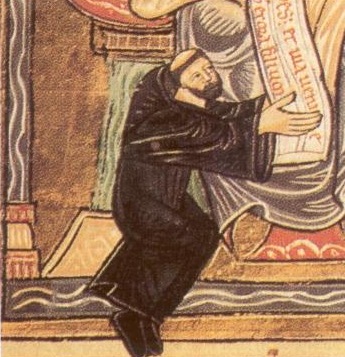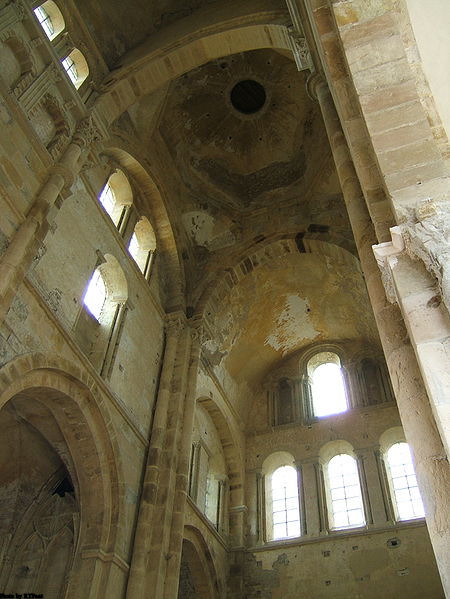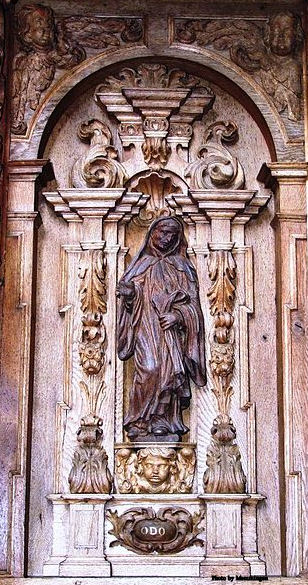St. Odo of Cluny
Odo was born in 879 in Maine, and was the son of a pious and surprisingly learned layman, Abbo. Though vowed by his father to St. Martin in babyhood, he was given a military training and became a page at the court of Duke William. But the exercises of war and hunting were unendurable to him, and he was permitted to fulfill his father’s vow by becoming a canon of the church of St. Martin at Tours. In this office he was in the companion-ship of worldly ecclesiastics. He revolted from the careless life which for a time he had practiced with them, and studied Vergil, till, warned by a dream of serpents in a jar, he abandoned the poets for the Prophets and Apostles. With Bible study he now mingled an exaggerated asceticism, keeping himself in a narrow and unfurnished cell.
He also read the Benedictine Rule, and proposed to become a monk. But the life of the monks at Tours, like that of the canons, was shocking to the earnest young ascetic. Odo now spent a period at Paris in the study of logic and music, and then returned to Tours to teach and write. But he soon set forth in quest of a suitable monastic home and we find him, in 909, entering with a companion Berno’s monastery at Baume. Here he distinguished himself by his humility, and in recognition of his learning was appointed master of the cloister school. He bore with invincible patience the hostility of unfaithful monks, and gained the complete confidence of Berno. At Berno’s command he was ordained a priest. When Berno died, early in 927, the monks of Cluny unanimously chose the saintly teacher of Baume as their abbot; and the better element of the Baume community followed him to Cluny.
With ripened gifts Odo devoted himself to the upbuilding of the young institution. In his first year of office he secured from Rudolph, the ruler of Burgundy, a charter which reaffirmed the terms of Duke William’s donation, and strongly emphasized Cluny’s immunity from all secular and ecclesiastical interference. The monks were exempted from tolls in the markets, and numerous valuable manors were added to the monastic property.
Secure in the control of the monastery, Odo proceeded to erect suitable buildings, first completing a church which was left unfinished by Berno. We know less of the buildings constructed by Odo than of the difficulties faced in the task. The institution was still distressingly poor and an empty treasury threatened to put an end to the building enterprise. But John of Salerno, Odo’s biographer, in the authentic style of medieval hagiographers, tells how St. Martin appeared, with kindly, bearded face, to Odo, promising that help would be provided. Confidence was restored; the hired workmen were retained; and funds were presently supplied by a generous gift.
Inside the Abbey of Cluny
Gifts and privileges, the world’s subversive reward to piety, now came to Cluny in a swelling stream. Numerous charters granted by kings and popes multiplied the guarantees of the monastery’s immunity from interference. Grants of property, villas with their serfs, churches with their revenues, and other sources of income, were made by wealthy laymen and women for the good of their souls. Bishops handed over church properties on an arrangement of easy annual payments of dues. From King Rudolph and the pope, the privilege of coining money was granted to the abbey. And in 931 Pope John XI presented to Cluny the extraordinary privilege of receiving from any disorderly monastery any monk who wished to amend his life, and harboring him until such time as his own monastery should be reformed. John XI was the son of the infamous Marozia; and there is a striking paradox in this cooperation of the Papacy, debased and dishonored as it then was, in the restoration of monastic discipline. There is a paradox, too, in the violation of the letter of Benedict’s rule of stabilitas loci that a monk should remain in his own monastery as a means of restoring the Benedictine spirit.
It is not possible to describe in detail the internal life of Cluny in Odo’s time, since the Customs of the monastery which have been preserved belong to a later period. Probably Odo was chiefly indebted to the regulations of Benedict of Aniane. Some of his principles are exhibited in his own writings, and in the lives of Odo and his early successors. He seems to have admitted Paul the Deacon’s interpretation of the rule of labor, that it might be fulfilled by some other employment than manual work. It is now held by good authorities that the monks of St. Benedict’s own cloister had the more menial work done for them by servants. Odo had a leaning toward study, and he laid the foundations of the later considerable literary development of Cluny.
Odo’s writings include a work called Conferences (Collationes, a title employed by Cassian who expounded the principles of Egyptian monasticism for Western readers about 430), which contains, amid much complaint of the wickedness of the selfish rich and of the worldly clergy, vigorous denunciation of the possession of private property by monks. At Cluny he enforced private poverty to the letter. He also excluded the eating of meat; a flesh diet was thought to induce fleshly sin. Yet his Life of Gerald of Aurillac is a panegyric upon a saintly man who ate flesh and drank wine in moderation, and of whom no miracles were recorded, but who was rich in good deeds, modest in apparel, and chaste in mind and behavior. It may be noted that while Odo believed in miracles, and many were alleged of him, he objected to making them the test of sainthood.
Cluny
John of Salerno notes the practice of certain hours of silence; but this was modified by the use of a language of signs, by which “grammarians of the fingers and eyes” might become articulate. When St. Benedict in his Rule admitted the use of signs, he probably did not foresee the expertness that would be attained in this art where extended silences were enforced. “If the monks were deprived of the use of the tongue,” John thinks, “those signs would suffice for all that they need to convey.” (Detailed codes of the sign language are contained in the sources of later monasticism; apparently some nunneries excelled in its use.) Great care was taken for the dignity of the services, and in accordance with the practice of Benedict of Aniane, the psalmody was extended beyond that of early Benedictinism.
Cluny was mounting to greatness. Pope John’s suggestion that degenerate monasteries were to be reformed, was to be carried out in hundreds of instances through the influence of the Cluniacs. Odo saw the beginning of this widespread restoration, and he was the traveling organizer of the movement.
Romainmoutier near Lausanne, Aurillac in southern Auvergne, and Fleury near Orleans on the Loire, were the first houses to enjoy, or suffer, transformation at his hands. He then went farther afield, to Sarlot, Tulle, Sens and Tours. His visitations were made at the request of some earnest ruler or bishop, and sometimes with the goodwill of a reforming minority of the monks. Each revived monastery helped to spread the revival to others, and the circle of Odo’s influence continued to widen. His work was sometimes violently resisted, however. At Fleury the monks took pride in their early history and in their possession of the relics of St. Benedict; they also took offense at the supplies of fish which Odo brought to replace their stock of meat. They met him with weapons; he withdrew only to return meekly riding on an ass. Then they repented and received him with tears. Fleury became a powerful ally of Cluny in the advance of reform.
Odo carried the movement into Italy, where many abbeys had suffered from raiding Saracens and predatory nobles. Alberic, then in control in Rome, and Pope Leo VII, invited him. Alberic in so doing may have been chiefly concerned to take from the hands of his political opponents the monastic properties they had seized. In the winter of 936, Odo, in peril and great hardship, first crossed the terrifying Alps. He was accompanied by John of Salerno whose description of the journey shows high admiration for the humility and charity of his master. The fame of Odo had preceded him, and he was greeted by throngs of common people and beggars. He became intimate with the folk, and liked to get children to sing in payment for the alms he distributed. Once, to relieve poverty, he bought laurel berries at an excessive price; and when asked by his companions what he intended to do with the berries he uttered a torrent of amusing explanations, making them laugh till they could not restrain their tears.
A mood of hilarity sometimes seized this earnest saint; but it was not his prevailing mood. He habitually walked with back bent and eyes fixed on the ground, a posture so suggestive of a laborer with a spade that he was nick-named “the Digger.” The bent shoulders carried heavy responsibilities.
St. Odo of Cluny. Choir stall in St. Maria (Buxheim)
Odo found Rome in a state of turmoil, and measures of pacification had to precede reform. Before he died he had made four protracted visits to Italy, and had achieved important successes. In Rome three monasteries were restored, and one, St. Mary’s on the Aventine, was founded by Odo. The historic house of St. Benedict at Monte Cassino, which had been wrecked and deserted, was planted anew. The reform was extended to a number of houses in southern Italy.
Enfeebled by malaria and fatigue, and knowing that his work was ended, Odo set out from Rome to use all his remaining strength in a journey to the shrine of his patron, St. Martin of Tours, and there, November 18, 942, he died an edifying death.
It remained for Odo’s great successors, Odilo (994-1048) and Hugh (1048-1109), to consolidate and extend the empire of Cluny. Odilo wrought the enlarging connection into a completely integrated order, monarchically controlled by the abbot of Cluny. Hugh built the vast and impressive abbey church, that celebrated monument of Romanesque architecture. The order grew till it included nearly a thousand houses, and as many others felt the stimulus of its example.
Whatever we may think of the desirability or undesirability in the abstract of monasticism, or of monarchy, we can feel only gratitude to the men who, on the impulse of religion, bore into the feudal chaos of the tenth century a conquering principle of organization and discipline, and thus made possible the direction of Western Europe into a course of cultural and social progress.
(from: Makers Of Christianity From Alfred the Great To Schleiermacher, by John T.McNeill. Publisher: Henry Holt And Company, New York, 1935)





No comments:
Post a Comment